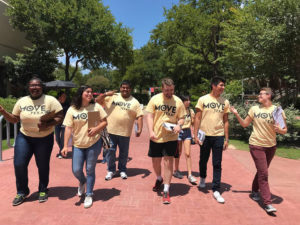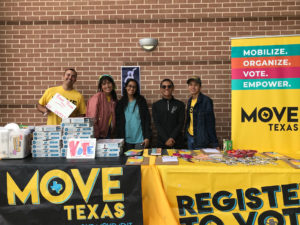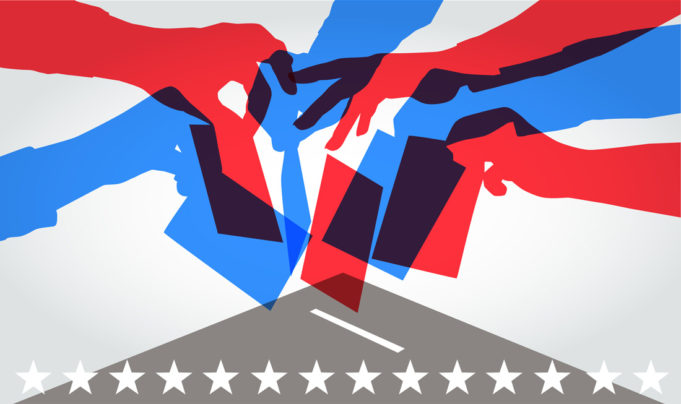In light of the COVID-19 pandemic and its more than 100,000 U.S. casualties, voting reform has become a heated topic. In Texas, electoral politics have been reduced to two talking points: public safety versus voter fraud.
“Protecting the integrity of elections is one of my most important and sacred obligations,” Ken Paxton said last month.
The indicted attorney general’s statement came soon after a May 15 Texas Supreme Court ruling to halt the expansion of mail-in voting during the COVID-19 pandemic. One week before the Supreme Court order, Paxton had asked the court to take action to stop a Travis County trial court’s decision to allow expansion of voting by mail.
For many Texas voters, the ability to vote without risking contracting a deadly and highly infectious disease is a health consideration and not a political one. Senior Texans, the most vulnerable population when it comes to COVID-19, are predicted to use mail-in ballots in record numbers this fall. Low poll numbers have historically served incumbents here and across the country. Many progressive and nonpartisan groups believe Paxton’s efforts to maintain restrictive voter laws during the pandemic will backfire come November 3.
The Travis County effort to expand mail-in voting was based on the state’s current rules for absentee ballots. Under the current rules, eligible Texas voters must be 65 years or older, disabled, out of the county, or confined in jail to qualify for absentee voting. Democrats in Travis County and supporters of the litigation, who ultimately lost their case, contended that lack of immunity to COVID-19 qualifies voters for mail-in ballot-casting under the election code’s definition of disability. Disability is defined as “a sickness or physical condition that will prevent him or her from appearing at the polling place for an election.”

Photo courtesy MOVE Texas.
Although the Texas Supreme Court has made its stance on COVID-19 immunity and disabilities clear, legal challenges to the state’s voting-by-mail rules continue in federal courts, including one in the U.S. 5th Circuit Court of Appeals that is currently being appealed. Challenges to voting restrictions may end up before the U.S. Supreme Court this year, many legal experts have noted.
The Texas Supreme Court ruling repeatedly stated that it is up to voters to assess their own health conditions. Voters who “cite disabilities can take into consideration aspects of [their] health and [their] health history that are physical conditions in deciding whether, under the circumstances, to apply to vote by mail because of disability,” the court said.
Voter registration applications, including absentee ballots, are handled by county voter registrars. Final votes are tallied by the Elections Division of the Texas Secretary of State.
Charlie Bonner, communications director for MOVE Texas, said voting restrictions, such as limited mail-in ballot options, should be seen for what they are.
“We have to understand that limiting access to the ballot is an intentional measure to prevent voting,” he said. “That is something that has been built up through voter-suppression laws.”
MOVE Texas, a nonpartisan nonprofit that works to engage young voters, was one of the plaintiffs in the suit that the Texas Supreme Court ruled against. A recent poll conducted by the Dallas Morning News and the University of Texas at Tyler found that, among Texas voters, 76% of Democrats support allowing universal mail-in voting while 42% of Republicans support expanding mail-in voting.
“We are seeing strong arguments being made about vote by mail,” Bonner added. “Many states already have this. Texans are asking for the right to make their voices heard. This is the logical and right thing to do.”
******

Photo courtesy MOVE Texas.
Travis County is not alone in its efforts to create safe and more convenient options for voting. A slew of recent litigation in Texas has sought to make voting more accessible in the Lone Star State.
Bonner and his colleagues predict that 2020 will see a sharp increase in mail-in votes, even if the current absentee guidelines remain in place. A large percentage of displaced college students will be eligible for mail-in ballots under Texas guidelines, and Bonner anticipate that a large percentage of senior voters will use mail-in ballots to avoid potential exposure to COVID-19.
Every state offers some form of mail-in absentee ballot, according to the National Conference of State Legislatures. Two-thirds of U.S. states offer mail-in options to any eligible voter — no questions asked. In one-third of states (including Texas), some level of qualification must be met. Five states (Colorado, Hawaii, Oregon, Washington, and Utah) currently conduct elections entirely by mail, according to the NCSL. Those states have an “election period” rather than an election day due to the fact that ballots are mailed out well ahead of Election Day.
In 1998, Oregon became the first state to pass the vote-by-mail system. Today, voters in the Beaver State overwhelmingly support their system. According to a 2016 poll by DHM Research, a nonpartisan opinion firm, 61% of Oregonians reported “very positive” impressions of their voting system, while 26% of residents reported “somewhat positive” impressions of the state system.
Since 2000, more than 250 million votes have been cast via mail-in ballots throughout all 50 states, according to the Vote at Home Institute. In 2018, more than 31 million Americans (25.8% of voters) cast their ballots by mail.
Two of President Donald Trump’s recent tweets about mail-in ballot voter fraud prompted Twitter to add “Get the facts about mail-in ballots” disclaimers. The social media company said the alerts are part of a new policy to identify false and misleading statements.
“Mail-in ballots are vulnerable to fraud,” Paxton recently said in a public statement defending his swift action to push back against expanding mail-in ballots. “Two-thirds of all election fraud cases prosecuted by my office involve mail ballot fraud.”
Paxton’s strongest case for voter fraud resides in Tarrant County (“ Voter Fraud or Politics as Usual?,” December 2016), where one of his investigations led to the arrest of four alleged vote harvesters — Leticia Sanchez, Leticia Sanchez Tepichin, Maria Solis, and Laura Parra — who were indicted on 30 felony counts of voter fraud for what the AG said were efforts to sway the votes of elderly Northside residents. In November 2018, a Tarrant County jury found Ortega guilty of voting illegally. She was sentenced to eight years in jail. Leticia Sanchez is currently awaiting jury trial in Tarrant County. We have not been able to confirm the whereabouts of the other two women.
According to the Brennan Center for Justice, a nonpartisan law and policy institute, voter fraud remains “infinitesimally small” despite the widespread use of mail-in ballots in the United States.
In Oregon, more than 100 million mail-in ballots have been used since 2000, and the state has documented around 12 cases of proven fraud, according to the Brennan Center for Justice. That amounts to 0.0000001% of all votes cast.
“We see little to no evidence of voter fraud or any of the associated arguments that partisan conspiracy theorists [like Paxton] whip up,” Bonner said. “When they make those arguments, real people do get hurt when real voters lose rights. We have to push back on that.”
******

Photo courtesy MOVE Texas.
In a state as historically rich and geographically expansive as Texas, Lone Star State residents could be forgiven for not knowing that our voting system is considered onerous and restrictive when compared with most of the country. Proponents of voter reform argue that voter restrictions translate to low voter turnout and better odds for incumbents.
Texas consistently ranks near dead last among states in voter turnout. In 2014, the Lone Star State was one percentage point away from sparing Indiana the ignominious title of state with the worst voter turnout.
“As far as voter restrictions goes, this is one of the most difficult places to register voters,” Bonner said.
A 2018 study conducted by Northern Illinois University ranked Texas as the fifth most difficult state in the nation in which to cast a ballot. Texas is one of 12 states that does not allow online voter registration. Bonner classified voter registration into three groups. The gold standard, he said, is automatic voter registration. According to NCSL, 19 states and the District of Columbia have automatic voter registration policies.
The next best option, according to Bonner, is online voter registration. According to NCSL, 39 states plus the District of Columbia offer online registration. Texas residents can request voter registration applications via Votetexas.gov/register-to-vote, but they must fill out the handwritten form and mail it at least 30 days before the election date. Relying on handwritten applications (the “worst” possible system, according to Bonner) creates errors that can lead to voters being turned away from the polls on Election Day, Bonner said.
Volunteers who wish to register voters have significant hurdles to jump through. According to the Texas Secretary of State, “volunteer deputy registrar appointments are made on a county-by-county basis,” meaning that anyone who is deputized to register voters in Tarrant County cannot register a Parker County resident unless that volunteer completes training and is deputized by a Parker County voter registrar.
Bonner, a resident of Austin, said, “It is easier for me to fly to Colorado and register someone to vote than to drive to San Antonio and register someone in Bexar County.”
To work around that restriction, MOVE Texas volunteers complete voter registrar requirements in several adjacent counties before registering voters at public events. Bonner and his network of volunteers are working on several fronts to expand access to voting in the Lone Star State. The nonprofit offers an online portal (Movetexas.org/register) that Texas residents can use to register to vote. Once completed, a pre-filled voter registration application (with postage included) is mailed to the applicant’s residence for final submission.
MOVE Texas staffers are working with counties across the state to ensure that there are adequate resources to receive and count mail-in ballots. The nonprofit predicts a sharp increase in the number of senior citizens and displaced college students who will opt for absentee ballots.
Voter ID laws, limited access to mail-in ballots, handwritten voter applications, and the county-by-county voter registrar requirement are onerous burdens designed to disenfranchise voters, Bonner said.
“What the pandemic has done is shine a light on inequities,” he said. “This pandemic has amplified the problems in Texas’ voting system, which is forcing us to take action right now, so we have free and fair elections in July and November. We could see the highest turnout election in history.”
******
Steps are being taken to lower the risk of spreading COVID-19 during upcoming elections. Gov. Greg Abbott recently took steps to expand the early voting period for the July primary runoff elections, which include the prominent race between MJ Hegar (a former Air Force helicopter pilot) and Republican U.S. Sen. John Cornyn. Early voting for the July 14 runoffs will begin June 29 instead of July 6. Local election officials are being left to decide how to safely conduct voting under the ongoing pandemic conditions.
Tarrant County elections administrator Heider Garcia said in an email that his group will “provide every poll worker with a fresh mask for each day, masking tape to mark 6-foot separations for voters in line, wipes with a disinfecting solution to wipe the machines every 30 minutes, and hand sanitizer for voters to apply before they show the ID to the poll worker and again after they have cast their ballot in the scanner.”
MOVE Texas volunteers see expansion of voting rights as inevitable. Texas voters are trending younger in age. Indeed, the Lone Star State has one of the youngest populations in the nation. A 2019 article in the Texas Tribune predicts that one in three Texas voters will be under 30 by 2022. Bonner, himself a twentysomething, said that voters in their late teens and 20s are less concerned with partisan affiliations and more focused on issues like climate change and voting rights.
A 2018 pre-election poll conducted by Tufts University found that one-third of voters between the ages of 18 and 24 identified their political views as independent.
“We are finding that young people are more disconnected from parties,” Bonner said. “They are still interested in being involved with their communities. Student debt, campus sexual assault, and voting rights are nonpartisan issues. Our group is trying to show young voters that these issues can be impacted by their vote. Our work is making sure that we can engage people in the political process even if they are not tied to a party.”
Trump’s claims that mail-in votes will lead to “tremendous fraud” and Paxton’s threats of criminal sanctions against third parties that advise voters to apply for mail-in ballots “based solely on fear of contracting COVID-19” are disheartening, Bonner said.
“Many roadblocks are being put up to prevent people from voting, even in the middle of a worldwide pandemic,” he added. “I think that this is going to be a critical year. I think that you are going to see many people turn out, whether they are 6 feet apart or preferably by mail. You will see people show up” to vote for politicians who support safe and equitable voting, because people are “angry with how this was handled.”
This story has been updated to reflect two errors.












